
Like the flip side of a valuable coin, I was looking out to the twin brother cliffs of Anaga and the distant rock spits of Almaciga – but this time from the La Laguna coast. Just 45 minutes on the 050 Titsa bus down through thriving towns like Tejina, and Tegueste, delivered me to the welcoming statues and a rough road to the Camino Punta del Hidalgo.


The rugged north coast of Tenerife has long drawn visitors up and over Santa Cruz and Las Teresitas beach. Here though the old crumbling houses and an abandoned car gave way to a gallery of murals but they couldn´t detract from the outstanding beauty on offer. The immaculate and colourful Hermita de San Juanito was further proof that I was on the right course. Rock pools made a cool enticing mosaics as they stretched out to where the sea lapped gently.



Many people immersed themselves in the series of shallow pools as others scanned the landscape for sea birds. Migrating species pass this way and add to the natural mix of local sea life and plants. This was the first time I had seen bird watching shelters at key points along a coastal walk in Tenerife. They contained pictures and details of the most common species that might grace this area, and thin viewing slots meant the birds wouldn´t get twitchy at their starring role. It all looked fairly new, even the bins were clad in wood and looked like they were regularly emptied. A pride and respect for nature is shared by local inhabitants who have a close dependency with nature.



A private sea water swimming complex was only in partial use, but there was a public access large rock pool further along on the walk. The sea was sedate on my visit but it can turn quickly off the north coast. A white guardian stood guard on an exposed turn to beam out a warning to passing shipping. The lighthouse was built in 1994 and can be seen up to 15 nautical miles away. This late comer has never had any keepers, all the lighthouses around Tenerife are automated these days. Technology also showed its hand in the form of a water cleansing station just off the main trail.




It´s not a long walk, 2.3 kms one way, around 45 minutes, but it is easily accessable and very interesting. Further along, housing faces onto the route and the Altagay apartment complex offers a cafe. The 050 bus stops just up from the beach at this point, just opposite an eye catching fish sculpture made from discarded waste by Diedel Klover.I retraced my steps back to the start to get another eye full of the cliffs. The birds were a little shy on this trip, winter months will bring more migrating friends. It was a lovely uplifting walk and a nice insight into life on the exposed north coast.

Drop kicking a goal between the two towers of the Centro Termica power station must have run through greater minds than mine. Chugging up the TF1 motorway from the south of Tenerife towards the capital, Santa Cruz, brings a few scowls of disapproval on the Titsa bus.

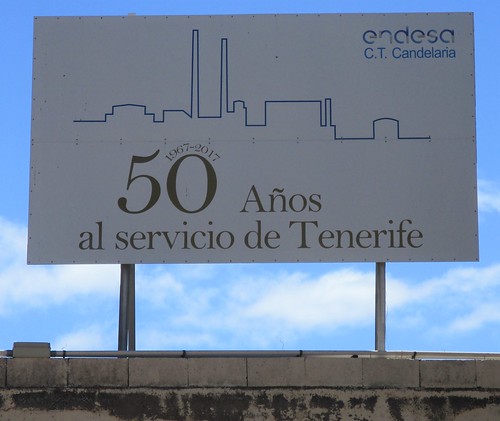
Time is catching up with the 1967 built gas and diesel power turbines and plans are in place to remove one of the 76.5 metre chimneys that overshadow a thriving small community below. For me it has become a good starting point for an extended coastal stroll to Candelaria. Long delayed improvement works are now cranking into life. A large solarium was being extended and bordered with sturdy fortifications against the often lively sea. A small cafe bar and two life guards showed that the spot is used by locals, just above a small plaza full of charm, also awaited a makeover.

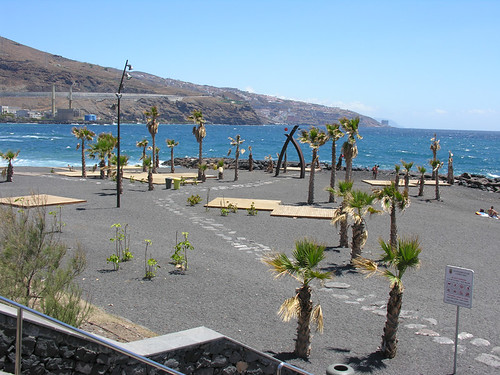

The four star Hotel Catalona Punta del Rey was busier than on my last walk by, a Rod Stewart disco soundtrack extolled the virtues of being sexy to a pool side exercise group. The main 1.8 million euro spend for Las Caletillas was approved in 2021, their main task will be to wipe out the eyesore debris of the old 3 star Tenerife Tour Hotel at the north end of the Playas Punta Larga beaches. The promenade board walks and lagoon style beach zones were partially protected from the wind, and a large stage awaited three free nightly rock concerts.
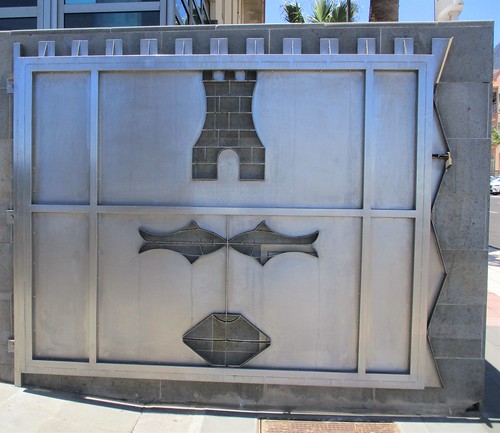


The heat scorched down as I reached the old marinas just ahead of the historic centre of Candelaria.The Ayuntamiento (council) building, impressed as always with its seven identical sculptures (representing the Canary Islands) along the high wall. Even the garage entrance had its own themed reference to local culture. As the busy shopping street opened out onto the Plaza de la Patrona, a three day Artesans Fair almost eclipsed the imposing frontage of the basilica church. Huge concrete blocks weighted down the giant marquee to keep the wind off the 49 stall holders showing off their traditional arts and crafts skills.



Meanwhile the waves were breaching the sea wall and soaking the statues of the Guanche tribal kings. Some visitors were blissfully unaware that three of the statues had to be re anchored last year after the pounding sea undermined them. Dancing in the sea spray for photos looked fun but part of me cringed as they laughed.

Candelaria lures the explorers in with coastal and hill walks in the more usual calmer weather days. They don´t leave the cyclists deflated or spinning their wheels. Bicibox repair points standing in Plaza Teror were like a Swiss army knife for peddlers, their range of free use attachments would put Halfords to shame. The Virgen of Candelaria reigns across the seven islands, the big day of homage is 15 August for 2022. The packed plaza will be further bulged by a 1,000 runners in a 7 am sprint down from La Granja in the hills, down through Las Caletillas to the heart of the celebrations. This part of the east coast is amazing at any time, drive, bus, walk, or cycle – just add it to your exploring itinery.

Hemmed in by the sacred mountain Fortaleza and a 9.000 year old black lava trail down to the sea, San Juan de la Rambla has had to dig deep to express itself. The result is a defiant and colourful municipality in the north of Tenerife.

The TF 5 road linking Icod de Los Vinos to Puerto de la Cruz delivered me from my TITSA bus, close ro one of several old concrete tunnels perched above the coast. Looking up it was a little dark and fornoding, especially taking the mini tunnel under the busy mainroad, but within minutes I was marvelling at the beauty in the old village of San Juan de la Rambla. The entire municipality boasts just under 5,000 inhabitants.


 The bright colours of the buildings and the well maintained flower borders showed a sense of pride at work, and plenty of tradition. A calvaro made a sturdy home for the religious crosses and just beyond, a small neat plaza led to some age weary old houses. Despite their peeling paint, they had a certain nobility about them. and a few scattered clothes washing troughs were another link to the past.
The bright colours of the buildings and the well maintained flower borders showed a sense of pride at work, and plenty of tradition. A calvaro made a sturdy home for the religious crosses and just beyond, a small neat plaza led to some age weary old houses. Despite their peeling paint, they had a certain nobility about them. and a few scattered clothes washing troughs were another link to the past.



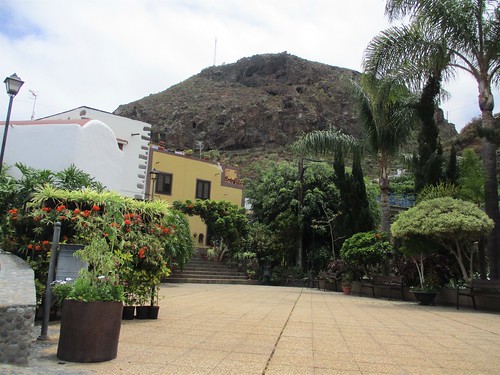
Local rock dating back 2 million years had been quarried on a small scale in the past and the work had taken its toll on many younger workers. Ornaments and even parts of the nearby cemetary were adorned with locally crafted work, some of the extracted ore was even transported to South America. A monument paid tribute to the hard and dangerous quarry work.
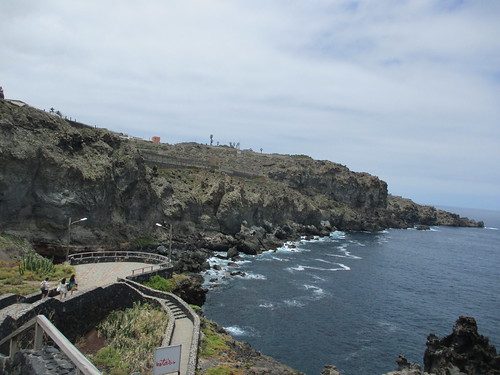


The village hasn´t sat still since its industrial past. A newer, low level housing development sloped down to the Charco La Laja rock pool via a reinforced series of paths and ample warnings of times and rides ro avoid. On this sunny afternoon, the sparkling water had attracted a small crowd of swimmers and anglers. High up above the popular dipping point, a small spring trickled water down to the sea, and views both ways along the coast showed a series of rugged coves.


Heading back up, I swerved along and past several welcoming bars and cafes before finding the church and plaza of San Juan (John the Baptist) with its very detailed clock face. Striding up to my original access point, I couldn´t help imagine how horrific the record rainfall floods of 1826 must have been as water swept down off the mountain. Work was underway to widen the entry point to the village and the closed Tourist Information office had plenty of good information and maps on disply outside. A couple of walks caught my eyes and will draw me back to check out a route from up the mountain and down through the Barranco Ruiz.

Was I getting a history lesson, botany class, or a grounding in landscape gardening? All were gratefully accepted as Parque Taoro in Puerto de la Cruz drew me up from the busy Carretera Jardin road below.



A crescendo of low stepped paths huddled around pools and water falls as they gently parted the green curtain of flora. It was to be a double pleasure as the circular galleries emerged above the tree line for great views of the north coast of Tenerife. Ceramic tiles showed glimpses of history and customs via the Guanches, the original inhabitants of Tenerife.



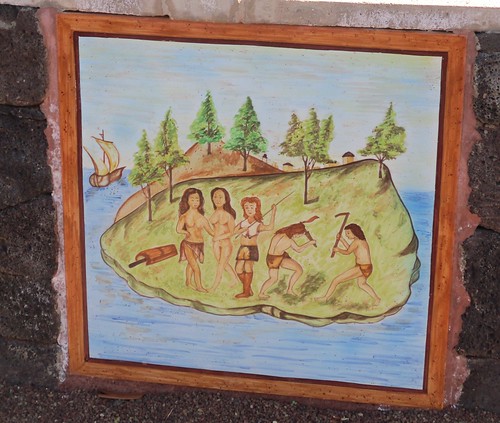
Big clearings with palm islands in ornate lakes vied for attention as Cuban born poet, Dulce Maria Loynaz, an adopted daughter of Tenerife, looked on with pride. Awarding myself a rest and a coffee at the Taoro Terrace Restaurant And Bar, I was in good company as people kicked back to enjoy the views or the shade.



Moving on past the abandoned former casino to the more modern, and groomed layout of Parque de La Sortija, I could see a lot of care and styling had gone into the huge leisure space. Neat paths, sport zones, even a large excercise zone for dogs, and a big feature was made of the intrusions of volcanic lava in wild twisting patterns. Gnarled ancient tree roots flexed their muscles in a proud show of age, and the meandering and split level walks allowed for plenty of secluded spots to take the sin or indulge in some light excercise.



Living in the shadow of the up market Jardin Tropical just up the road hasn´t bothered these parks. Its all free and open from 10 am to 8 pm apart from Friday, Saturday, and Sunday when its late opening to 10 pm.
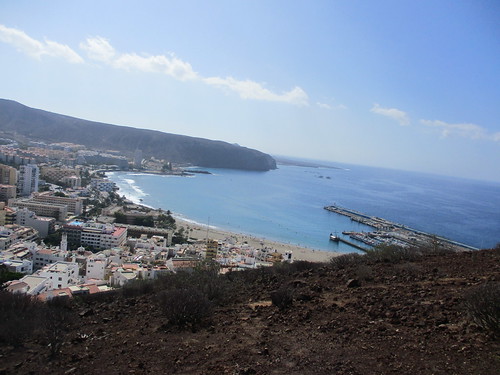
It may be just 115 metres high but Montaña Chayofita opens windows onto Los Cristianos . It´s past, and ever evolving present and future are put into glorious perspective. Accessed from the track opposite Parque Santiago 6 , the collapsed volcanic cone has a clear rising circular path.

The table top Roque del Conde is the 1001 metre inland guardian at the southern end of Tenerife. The Arona outdoor pool, and sports centre look welcoming from the elevated position as the modern snaking Green Mile Bridge seems like a Scalextric circuit as it vaults the bypass to Playa de Las Americas. Of course the sea is soon calling as the path rises to reveal the ferry port and Playa de Los Cristianos as it stretches away to the foot of Montaña Guaza. The skyline has changed dramitcally as hotels and apartments have marched out from the fishing community.

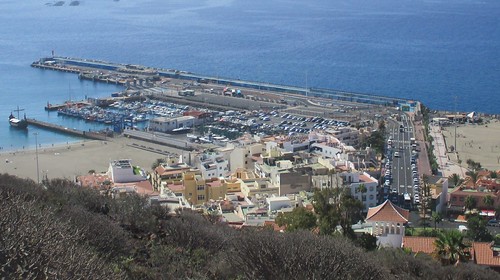
In times of crisis the ferry port has been a vital artery to the islands of La Gomera, El Hierro, and La Palma. Often it¨s summer forest fires that need help but the recent volcnic eruption of Teneguia on La Palma has required a constant stream of diverse emergency support services. Currently debate centres on the need for an alternative port at Fonsalia, the west coast closest point between Tenerife and La Gomera. Others favour expansion of Los Cristianos.



All is calm below on the 700 metre long Playa Las Vistas. A rock peninsula with fountain is a popular landmark but planning follies are close at hand. A half built mansion has scarred the mountian for decades, and a recent white elephant complete with crane defies logic and coastal protection laws. The long established sandy coloured Los Torres twin towers and the sky blue Mare Nostrum Resort pop up on many a holiday snap.


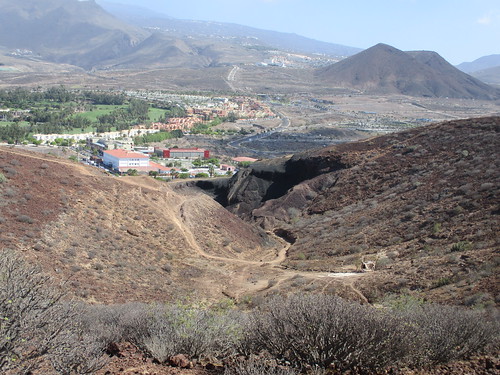
The mountain path comes full circle before dipping down and giving views of another modern addition, Arona Court, an imposing sight in front of the Golf Las Americas course. Back in the base of the cone, modern gives way to ancient as the black rocks reach out from across the centuries. A service road to the half mansion screams private property, next to a newer official Arona council sign proclaiming Montaña Chayofita Camino (walk) , one of many contradictions to the areas status. Back in 2013 I watched a horse based challenge on the mountain road involving sortija type jousting to spear overhead metal rings.

Whatever your outlook, Montaña Chayofita is quite an eye opener and is like spinning a rack of old postcards of Los Cristianos.
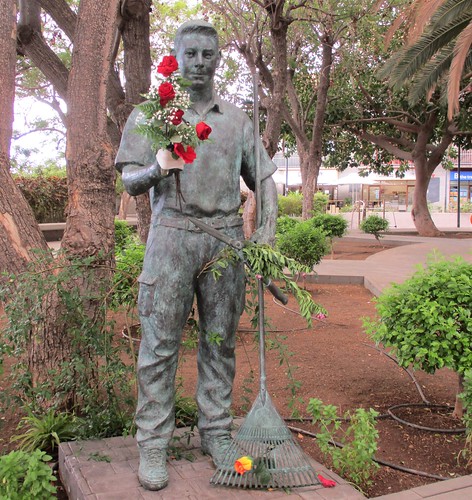
Green fingers were restored to good health for “the gardener” at Plaza de las Flores in Guimar. As sculptures don´t get frost bite, a previously chipped hand was glad of some wrapping to ensure a return to blooming pride. The fountain was pouring and a good scattering of visitors took time out on the benches. Among the well trimmed greenery, dogs were discouraged from leaving their mark.


It was a step off point for me involving the recently improved Valle de Guimar Titsa bus network. A scenic zig zag ride down to Candelaria racked up plenty of new ideas for walks and visits. The Guimar link 127 route crossed the TF1 motorway and mestled in Plaza de La Villa de Teror, a short stride from the beaches and the Plaza de Basillica to check on some more stone casualties.

Constant powerful waves had eroded the ground from under four of the statues of the Guanche kings at the end of 2020 but now restoration was underway at a cost of 602,338 euros. Six months should see the nobel figures back on firm bases by December 2021. Even with the work going on the sea was throwing in the odd bigger wave, and the building site setting would have dented anyones pride, but neither the interuption or cheeky seagulls could phase the kings.


The plaza was compensating with a homage to local born artist Dimas Coello. A full range of events were scrolling out through 2021 and samples of his work were spread across the busy plaza. Rejuvination was in the air, a few bars and cafes had opemed outside terraces during the restrictive Covid measures that denied inside gathering. A makeover was also underway at the nearby cultural centre, the year long huge nativity scene was covered but will hopefully return with a new artisitc look.
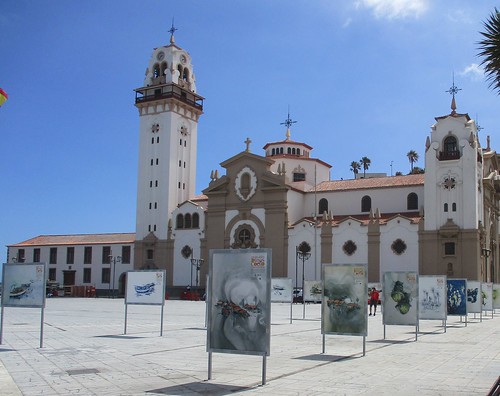


Back at Plaza de La Villa de Teror there was a new urban transport initiative involving pre ordered taxis on five set routes to open up the remote coastal and high altitude villages for the elderly and those with limited mobility. A similar scheme has already trialled in Fasnia with much success. Looking firther north along the coast, Las Caletillas is about to receive a 2 million euro upgrade of the promenade and beach areas over the course of 14 months. All these projects will go a long way to lift the recently under fire economy – and lure me back for regular check ups.

Was that a stoney glint in Agatha Christie´s eyes? Maybe it was anticipation of the fourth festival in her name in Puerto de la Cruz. The 5 to 14 November homage to the British crime writing legend is based on her time in the north Tenerife city writing a short story called “The Enigmatic Mr Quinn”. It was just one of the events waiting to welcome people back to the coastal delight.



Just a month after the restart of the TITSA 343 bus service between Costa Adeje, Los Cristianos, and Puerto de la Cruz had a dozen passengers on board, a good increase on my last trip under the Covid restrictions. On and offs at Tenerife South, and Tenerife North airports still left a half full bus when I bailed out at La Paz on the outskirts of the city centre. Agatha´s statue had new friends, two yellow shirted ladies offered information and advive under the city´s Safe Tourism banner. The cafes down the wide walkway to Playa Martianez were bristling with customers.


A mix of hot sun, mingling crowds and big waves all added to the busy vibe, and it was good to see hotels with open windows and busy balconies. The return of the scrawny parrots for photo sales was not so welcome, at least there was something more imaginative in the form of a wood art guitar bike. It featured initials of the worlds greatest players and a few young passers by twanged out some great riffs. The back street murals had been joined by a few new additions, notices promised that the next day the returning street market would provide more reasons for exploring the back streets.

Heading out to the rough car park parade overlooking Playa Jardin, the new face of the city was emerging. All traces of the old outdoor swimming pool were gone as the 8 million euro aquatic centre rose from the shallow end. Next door, the El Penon football stadium was ready for its new beighbour and will again show its versatility as a venue by staging Penon Rock on 15 October. Last year it staged two days of similar music under tougher Covid restrictions. Back in the centre of town, Timanfaya Cinema was offering regular music shows with tribute acts like Robbie Williams, in the Sala Teatro.


My bus ticket was demanding more miles, so I headed up to Los Realejos Alto and the Ayuntamiento building at the top of the town. Photo art filled the council plaza, full marks for hospitality, they invited me inside their historic building. Passing a small open public library and a stained glass version of the municipality crest, I was able to look down on the art exhibits from the balcony. The photos were part of a competition for students in the local photography course – very impressive.
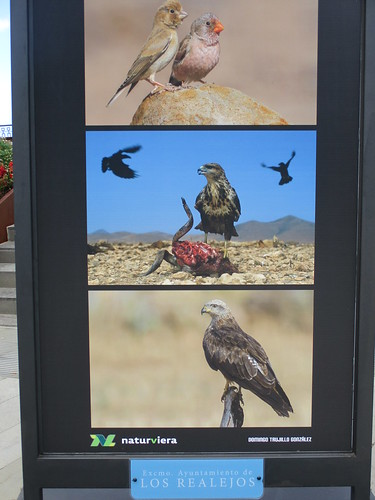
More bus routes and stops had been added to the streets that unwound down to Los Realejos Bajo. I tried the 390 route for some different views on its way past the popular eatery El Monastario. My hunger was fuelled for another trip soon to try the steep path up to the isolated church of La Montaneta

Teno rural park, the pools, caves, and peaks of Erjos, and the last big volcanic eruption site at Chinyero. They are all linked by popular walking trails, but dig deeper into the soil of this north western corner of Tenerife and a common bond is revealed. A trip to the El Tanque Eco Museo will show how a special bond between nature and people was forged by hard work and respect.


Nestling between a pine forest and and view to the distant ocean, a huddle of renovated 17th century farm buildings with courtyards, threshing circles, and even spme small caves to shelter goats, have plenty of tales to tell. An ancient plough stands proud on the roundabout by the entrance ro the museum, just above the Los Llanos turning where Santiago del Teide blends into Erjos. A short walk up from the Titsa bus stop by Bar Fleyta or a drive to the ample car parking of the museum is all that´s needed.


Inside the FREE museum, old rural tools are complimented by interactive display screens in English, Spanish, and Germman, with GR codes ready to give phone access to personal testimonies from people who have worked the volcanic enriched soil. There´s even solar panels to save energy – very ancient meets modern.



There were no such short cuts in the past, seasons were long and hard with ground being broken, fertilised and seeded before a range of cereals and potatoes could be grown. Threshing was also a long process of around six weeks with cereal crops dried in the sun and then raked over by a threshing board pulled by oxen or horses. Whole families would take part, it was a big social event with songs, stories, and meals shared as they worked. Every year a threshing fair still takes place in the last week of July to preserve and celebrate yhose traditions.



Large picnic areas now encourage visitors to linger on their visit. The museum is open every day except Monday, from 1st June to 30 September from 11 am to 6 pm, and from 1st October to 31st May – 10.30 am to 5.30 pm. The museum can arrange group visits and tours, just contact them via the website. Whether your rural knowledge is a seedling or fully grown, the museum will make you feel closer to nature.

Memories of summer camps as a very green “brussel sprout” resurfaced as sweet scented blooms emerged from delicate bushes. Puerto del Erjos bus stop was just a few downward strides in my wake with Santiago del Teide, and Masca shielded by green ridges. The north west of Tenerife added parched trails and volcanic outcrops to daydreaming of my lost youth, and the heat was a much different setting from those rainy walks.
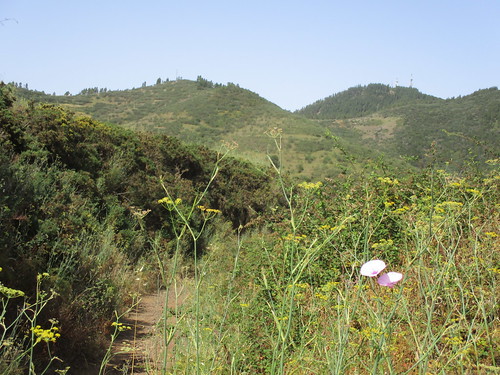


Bird song drew me to the pools in the wetland spread but on this August day they were distinctly dry. It was a start reminder of how quickly nature can change, in recent years wild fires had swept through the area but the balance had swung back and new growth sprouted at every turn. My aim this trip was to head for the black caves on the lower trail to the coast of Los Silos. Heading across to the white church tower in the hamlet of Erjos, I ploughed down a bumpy track between a cluster of old houses. A few months before, I had taken the high road up and over Monte de Aqua above the rising tree line. This was more of a hidden pleasure as the track narrowed and sunlight speckled the ground through a curtain of leaves.



It was short of markers and outside sound was filtered to a low level, I was grateful to a narrow water pipe that stretched ahead of me with reassurance that I was making progress. It gave me time though to appreciate the delicate shades of the leaves thrusting their heads up towards the light in the few spaces that appeared. The gaps became bigger and I got clear views of the cave openings that seemed to suggest facial features.



Not mnay other walkers desturbed my reflection, although there always seems to be at least one super fit athlete running against the flow. A family group from the Czech Republic stopped for a chat at they started at the coastal end – Tenerife´s walking pedigree reaches far beyond our shores. It was difficult to guess how far back the caves went but there were plenty of them to offer valuable shelter for farmers and traders as they cut off a long round trip against the sometimes fierce waves that batter the coast.


The final stretch gave me a base upwards view of mountains that I had viewed across barrancos, either way it was an impressive sight. Los Silos loomed into view and my path converged with the concrete path that cut directly out to the bus stop up past Garachico and into Icod. My admiration of Erjos had risen another few notches, theres still plenty more variations to explore and the seasons will keep changing the outlook on what I have seen so far.
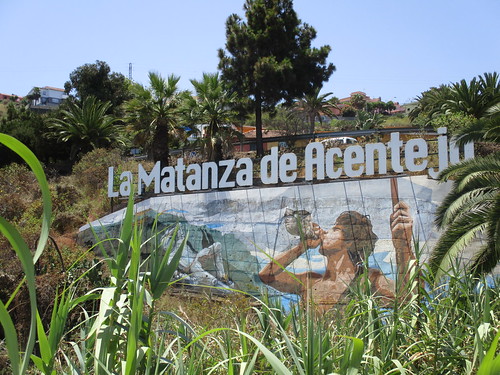
An iron clad Spanish conquistador reeled at the feet of Guanche warrior, Tinguaro, as he sounded a defiant call on a conch shell. Cars thundered by on the Tenerife north motorway between Santa Cruz and Puerto de la Cruz below were oblivious to the large mural but I felt like I was straddling two ages as I gazed through the wild grass.


Not that I was feeling critical of the local council gardening services for La Matanza de Acentejo. A worker was expertly trimming the garden on the rise into the town, It set the tone for the overall appearance of the municipality, a small picnic area with seating overlooked the dual carriageway. The rest area also featured a modern art version of the brother of Mencey Bencomo, one of the original tribal kings and a key player in the rearguard stand to delay the Spanish invaders back in 1495.

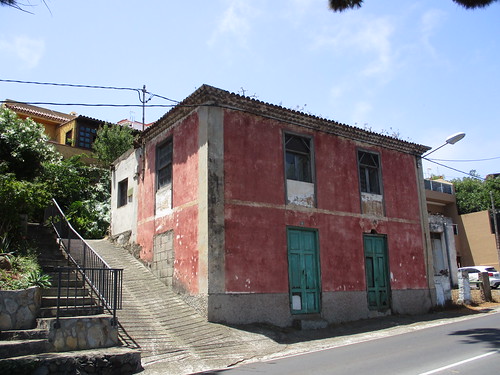

A mix of old dwellings and vineyards steerd me up a steep climb , beckoned by the twin towers of the El Salvador church. There were more benches and breather points along the way. From one I watched as two chickens played out their own turf war below a canopy of green leaves and ripening grapes. The church and large plaza were noble and well tended, A school of music, and a centre for people of the third age (such a nicer term than OAPs) boosted the range of facillities. Posters for a series of concerts featuring Cuban music kept up the cultural choices.





Heading back down to Calle Real, the street that meanders through the town, it was quiet but a few people were adding little proud brush strokes and repairs to houses with plenty of character. Plaza de Cuchareras gleamed brightly as the Ermita looked down on the roses and the fountain . It was a fair walk along to the end of town, a modern sports centre offered plenty of excercise to keep bodies nimble for treading the higher parts of town. With the coast far down below and the looming figure of Mount Teide above, La Matanza had plenty to say for itself before the road meged into the start of La Victoria. This corridor of the north keeps calling me back, and i have still only scratched the surface.






























 The bright colours of the buildings and the well maintained flower borders showed a sense of pride at work, and plenty of tradition. A calvaro made a sturdy home for the religious crosses and just beyond, a small neat plaza led to some age weary old houses. Despite their peeling paint, they had a certain nobility about them. and a few scattered clothes washing troughs were another link to the past.
The bright colours of the buildings and the well maintained flower borders showed a sense of pride at work, and plenty of tradition. A calvaro made a sturdy home for the religious crosses and just beyond, a small neat plaza led to some age weary old houses. Despite their peeling paint, they had a certain nobility about them. and a few scattered clothes washing troughs were another link to the past.





















































































